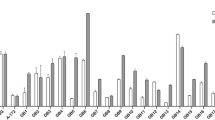Summary
We have examined O6-methylguanine-DNA methyltransferase (O6-MT) activity of rat brain tumour cell strains with reference to cellular resistance to antitumour nitrosoureas, 1-(4-amino-2-methyl-5-pyrimidinyl) methyl-3-(2-chloroethyl)-3-nitrosourea hydrochloride (nimustine, ACNU) and methyl-6-[3-(2-chloroethyl)-3-nitrosoureido]-6-deoxy-α-D-glucopyranoside (ramustine, MCNU). The values of O6-MT activity were 52 and 160 fmol/mg protein extract in 9 L and C 6 rat brain tumour cells, respectively; while HeLa S 3 cells, as a methyl excision repair positive (Mer+) cell strain, revealed a rather high value of 488 fmol/mg. 9 L cells indicative of a low O6-MT activity showed 13 μM for ACNU and 18 μM for MCNU at a 10% survival dose (SD10), determined by a clonogenic cell assay as an index of cellular resistance. In contrast to this, C 6 cells revealed a SD10 value of 67 μM and 36 μM for ACNU and MCNU, respectively, indicating higher resistance than 9 L cells. HeLa S 3 cells showed the highest SD10 value as follows: 84 μM for ACNU and 73 μM for MCNU. The relationship between the O6-MT activity and the cellular resistance was almost linear, with relatively resistant cell lines exhibiting the higher levels of the O6-MT activity. This correlation between the O6-MT activity and the cellular resistance to nitrosoureas as ACNU and MCNU was not observed among other antitumour drugs, which included bleomycin (BUM), neocarzinostatin (NCS),cis-diamminedichloroplatinum (II) (CDDP), and etoposide (VP-16) in clinical use for brain tumour chemotherapy. This indicates that O6-MT activity can be an indicator of cellular resistance to antitumour nitrosoureas in the chemotherapy of brain tumours.
Similar content being viewed by others

References
Benda P, Lightbody J, Sato G, Levine L, Sweet W (1968) Differentiated rat glial cell strain in tissue culture. Science 161: 370–371
Erickson LC, Laurent G, Sharkey NA, Kohn KW (1980) DNA cross-linking and monoadduct repair in nitrosourea-treated human tumor cells. Nature 288: 727–729
Ikenaga M, Tsujimura T, Chang HR, Fujio C, Zhang YP, Ishizaki K. Kataoka H, Shima A (1987) Comparative analysis of O6-methylguanine methyltransferase activity and cellular sensitivity to alkylating agents in cell strains derived from a variety of animal species. Mutation Res 184: 161–168
Karran P, Lindahl T, Griffin B (1979) Adaptive response to alkylating agents involves alteration in sites of O6-methylguanine residues in DNA. Nature 280: 76–77
Lowry OH, Rosebrough NJ, Farr AL, Randall RJ (1951) Protein measurement with the Folin phenol reagent. J Biol Chem 193: 265–275
Lowry OH, Berger SJ, Carter JG, Chi MMY, Manchester JK, Knor J, Pusateri ME (1983) Diversity of metabolic patterns in human brain tumors: Enzymes of energy metabolism and related metabolites and cofactors. J Neurochem 41: 994–1010
Mineura K, Fushimi S, Itoh Y, Kowada M (1988) DNA lability induced by nimustine (ACNU) and ramustine (MCNU) in rat glioma cell. J Neurol Neurosurg Psychiatry 51: 1391–1394
Schimizu F, Arakawa M (1975) Effect of 3-[(4-amino-2-methyl-5-pyrimidinyl)methyl]-1-(2-chloroethyl)-1-nitrosourea hydrochloride on lymphoid leukemia L-1210. Jpn J Cancer Res (Gann) 66: 149–154
Schmidek HH, Nielisen SL, Schiller AL, Messer J (1971) Morphological studies of rat brain tumors induced by N-nitrosomethylurea. J Neurosurg 34: 335–340
Sekido S, Ninomiya K, Iwasaki M (1979) Biologic activity of MCNU: A new antitumor agent. Cancer Treat Rep 63: 961–970
Takakura K, Abe H, Tanaka R, Kitamura K, Miwa T, Takeuchi K, Yamamoto S, Kageyama N, Handa H, Mogami H, Nishimoto A, Uozumi T, Matsutani M, Nomura K (1986) Effects of ACNU and radiotherapy on malignant glioma. J Neurosurg 64: 53–57
Tong WP, Kirk MC, Ludlum DB (1982) Formation of the crosslink 1-(N 3-deoxycytidyl)-2-(N 1-deoxyguanosinyl)ethane in DNA treated with N,N′-bis(2-chloroethyl)-N-nitrosourea. Cancer Res 42: 3102–3105
Tsujimura T, Zhang Y, Fujio C, Chang HR, Watatani M, Ishizaki K, Kitamura H, Ikenaga M (1987) O6-methylguanine methyltransferase activity and sensitivity of Japanese tumor cell strains to 1-(4-amino-2-methyl-5-pyrimidinyl)methyl-3-(2-chloroethyl)-3-nitrosourea hydrochloride. Jpn J Cancer Res (Gann) 78: 1207–1215
Walker MD, Green SB, Bvar DP, Alexander E, Batzdorf U, Brooks WH, Hunt WE, MacCarty CS, Mahaley MS, Owens G, Ransohoff J, Robertson JT, Shapiro WR, Smith KR, Wilson CB, Strike TA (1980) Randomize comparisons of radiotherapy and nitrosoureas for the treatment of malignant gliomas after surgery. N Engl J Med 303: 1323–1329
Author information
Authors and Affiliations
Rights and permissions
About this article
Cite this article
Mineura, K., Fushimi, S., Kowada, M. et al. Linkage between O6-methylguanine-DNA methyltransferase (O6-MT) activity and cellular resistance to antitumour nitrosoureas in cultured rat brain tumour cell strains. Acta neurochir 103, 62–66 (1990). https://doi.org/10.1007/BF01420193
Issue Date:
DOI: https://doi.org/10.1007/BF01420193



